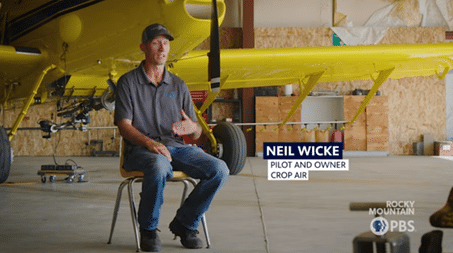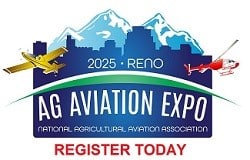Click on the article title below to be taken directly to the article. After you’re done reading the article, click “Back to Top” at the bottom to be brought back to the Table of Contents.
Table of Contents
- GRASSROOTS ALERT: Your Comments to FAA are Urgently Needed to Oppose Requiring Manned Aircraft Provide Drones Right of Way
- In PBS Interview NAAA Member Neil Wicke Highlights Complementary Role of Manned Aircraft and Drones in Agriculture
- Register Now for 2025 NAAA Ag Aviation Expo in Reno
- 2026 NAAA Membership Renewal Now Open
- AD Issued for Hiller UH-12E Main Rotor Driveshaft
- Superseding AD Proposed for AStar Vertical Fin Spar
GRASSROOTS ALERT: Your Comments to FAA are Urgently Needed to Oppose Requiring Manned Aircraft Provide Drones Right of Way
The aerial application industry is facing an existential crisis with the recent release of the FAA’s Beyond Visual Line of Site (BVLOS) proposed rule for unmanned aircraft systems (UAS). The reason for such concern is that the FAA has proposed that certain UAS operating BVLOS within 50 feet of shielded areas (powerlines and substations, railroad tracks, bridges, pipelines, etc.) be exempt from equipping with detect and avoid devices such as ADS-B In; AND would be granted right-of-way over manned ag aircraft. This means that agricultural aircraft (and any other aircraft operating in the low altitude airspace) operating near and passing through these shielded areas while applying to a field would bear the sole responsibility for detecting and avoiding a collision with a UAS operating within the shielded area.
FAA contends there is a low risk of a collision between a UAS and an agricultural aircraft flying near shielded areas because they claim agricultural aircraft do not operate near shielded areas. This contention is blatantly false – NAAA data and FAA’s own UAS safety research center data prove that aerial applicators routinely fly within 25 feet of powerlines when entering and exiting fields. This is the most dangerous provision of the proposed BVLOS rule, and NAAA strongly opposes it. To review the FAA UAS BVLOS rule click here. The shielded area proposal would also negatively impact UAS making aerial applications.
Your help in submitting comments to the FAA is crucial to inform the agency of the marked amount of work conducted to protect cropland, forestry and public health around shielded areas from aerial spray operations, and the extreme danger that the shielded areas proposal poses on human life for manned ag aviation operations and aircraft equipment for both manned and unmanned ag aviation operations.
The proposal is presently available for public comment until October 6, 2025. NAAA is urging agricultural organizations that rely on aerial crop spraying, aerial applicators and state and regional ag aviation associations nationwide to comment on the dangers of this proposed rule. NAAA does recommend posting comments closer to the close of the comment period. To comment on the rule, click here. Then follow the prompts to either directly write comments or upload them. Please reference: Docket Number: FAA-2025-1908 in your comments. A draft of NAAA’s comments may be found by clicking here.
Follow the NAAA format in drafting your own comments, such as using your own personal or company letterhead. PLEASE DO NOT COPY AND PASTE NAAA’s COMMENTS VERBATIM AND USE THEM AS YOUR OWN! Regulatory agencies give credibility to thoughtful, original comments and assign less weight to duplicative form letters. When drafting your comments, please emphasize the following points:
- Personalize your comments and elaborate on the geographical area in which you treat crops aerially, including acres treated, crops treated, number of farmer customers, value you contribute to agricultural production and public health protection, etc. in your local area (see pages 1-2 of NAAA’s comments on the scope, value and importance of the aerial application industry).
- Comment on the frequency in which you fly around shielded areas—from powerlines to railroad tracks to other utility lines—and the risk that would pose to you if certain drones could operate there without detect and avoid technology and they had right-of-way over your aircraft (see pages 3-6 of NAAA’s comments for the frequency and proximity that aerial applications operate around shielded areas from data from the FAA’s own Center for Excellence for UAS Research – Alliance for System Safety of UAS through Research Excellence (ASSURE)).
- Reference the difficulty in visually observing drones as an aerial applicator and the severe handicap this would pose to you if you had to provide them right-of-way when they are not required to use ADS-B or any other detect and avoid technology (see pages 6-7 of NAAA’s comments on points covering the difficulty of crewed aircraft pilots sighting drones).
The way to effect absolutely needed change, which includes the elimination of the FAA shielded areas proposal, is to comment in great numbers with factual data. That is what NAAA’s comments have attempted to do, but we need an active response to the FAA to emphasize the massive safety implications this proposal will cause. So please, please comment! NAAA is also working on urging responses in opposition to this FAA proposed rule from other federal agencies and national agricultural and national aviation groups. If you have questions while working on your response, please reach out to NAAA for assistance.
In PBS Interview NAAA Member Neil Wicke Highlights Complementary Role of Manned Aircraft and Drones in Agriculture

In a recent interview with Rocky Mountain PBS and KUNC News in Colorado, NAAA operator member Neil Wicke shared his insights on the growing role of both airplanes and drones in shaping the future of agricultural aviation. Read the article and watch the segment here.
Wicke has owned his company, Crop Air, LLC, in Eaton, CO, since 2018, serving farms from Brighton, CO, to Cheyenne, WY.
Wicke emphasized in the segment that drones and aircraft aren’t in competition. It’s about selecting the right tool for the job and size of the field. “It’s not us versus them,” he said. “You wouldn’t use an airplane to spray my quarter-acre yard—it’s just too big of a tool.”
As development spreads across Colorado, new obstacles, like nearly 200-foot power lines, make flying riskier. To adapt, Crop Air has added a drone, which allows for precise applications and access to previously untreated fields.
FAA data shows a sharp rise in ag drone registrations, with about 1,000 U.S. pilots now certified. Globally, drone use is booming, with over 400,000 agricultural drones in service in 2024 alone. Still, drones can’t match aircraft in speed or capacity. They’re a supplement—not a replacement.
With older ag pilots retiring and fewer young ones taking their place, the industry is at a crossroads. But Wicke and his team are finding ways to keep up. Crop Air is betting on a hybrid future, which is traditional aircraft for high-capacity work and drones for tight access. It’s a balance of legacy and innovation that Wicke and his team hope will keep their customers’ crops and livelihoods thriving.
Rocky Mountain PBS reaches about 5 million viewers annually. See more on the story here.
Register Now for 2025 NAAA Ag Aviation Expo in Reno

We look forward to seeing you at the 2025 NAAA Ag Aviation Expo in Reno, Nevada, Nov. 17-19. Attendee registration is now open for the annual convention. Exhibitors can purchase booth space here.
NAAA’s registration system will allow you to register and pay for all events at one time, including:
- Ag Aviation Expo registration for yourself, your spouse, children and other employees in your company.
- Saturday, Nov. 15 – Flying in the Wire & Obstruction Environment and Turning an Ag Plane Safely Courses (free, but registration is required)
- Sunday, Nov. 16 – Betting for PAASS: Casino Night NAAREF Fundraiser
- Monday, Nov. 17 – Support Committee’s ‘Sip, Savor and Socialize’ Food & Wine Tasting (capped at 100 participants)
Besides great programming, you’ll enjoy a vibrant city offering a mix of gaming, great food, drinks, and adventure in Reno, where high desert charm meets high-energy entertainment. Reno offers a lively mid-town area packed with local breweries and bars, unique eateries and year-round festivals. Explore the Riverwalk District, try your luck at iconic casinos, or take a short drive to the breathtaking landscapes of Lake Tahoe. Reno delivers a perfect blend of culture, fun and unforgettable Western spirit.
Whether you’re an industry veteran or a low-time or no-time ag pilot, the Ag Aviation Expo promises to deliver invaluable insights, the latest technological advancements, and a chance to connect with peers from across the nation and the world. Join us in Reno for an unforgettable experience that will help you soar to new heights in your ag aviation journey.
Ag Aviation Expo Details
- Dates: Nov. 17-19
- Schedule of Events here
- NAAA Hotel Room Block: Open
- Attendee Registration Open
- Exhibit Booth Sales: Open
- Sponsorship Opportunities here. We have sponsorships available for all budget sizes.
- Auction Donations: Please consider donating to the Live and Silent Auction. The earlier you inform us of your auction donation, the more advertising you will receive on the NAAA website and in NAAA publications. Support the aerial application industry by donating an item today. Email Amy May with your donation details.
- Never been to Reno? Learn more here.
- Flying Into Reno: Reno-Tahoe International Airport (RNO) has eleven airlines providing more than 120 daily departures and arrivals. Learn about travel here.
2026 NAAA Membership Renewal Now Open

Thank you for your support as a 2025 member of NAAA. We request your continued support by renewing your NAAA membership for 2026 today. While you have been busy aiding farmers to produce a safe, affordable, and abundant supply of food, fiber, and bioenergy, NAAA has been busy making sure low-altitude airspace is safe for your aerial application business to operate, as well as ensuring that you have the pesticide products you need to do your job. Several of NAAA’s accomplishments this year, on your behalf and to ensure your success, include:
- NAAA continues to lobby the FAA to include NAAA language ensuring the safety of manned aircraft from drones operating beyond visual line of sight. In response to FAA’s proposed rule on the topic, NAAA will provide evidence-based comments to the FAA defending crewed aircraft’s right-of-way over drones in all circumstances.
- NAAA has defended the use of ensuring sound scientific methods and application practices in the registration and use of pesticides to key administration officials of the Make America Healthy Again (MAHA) commission via hands-on field demonstrations, White House meetings and comprehensive comments to MAHA officials.
- Since 2017, NAAA has submitted over 300 comments to the EPA to keep aerial application use on pesticide labels with great success, enabling you to keep a deep inventory of pesticide tools without unnecessary and burdensome restrictions.
- NAAA released an aerial applicator’s Flight Risk Assessment Tool (FRAT) to enhance agricultural aviation safety.
- NAAA has urged the Department of Commerce and other federal agencies to leave aircraft engines and related ag aviation parts free of tariffs.
- NAAA and NAAREF have grown the online education center, which includes educational videos and C-PAASS certification for aerial applicators who want to augment their safety and professionalism and be recognized and rewarded by their insurance providers, pesticide manufacturers, regulators, and customers. Learn more at education.agaviation.org.
- NAAA offers health and life insurance options for members. Visit agaviation.org/membership for details.
In 2026, your NAAA membership will continue to provide valuable benefits that support your business and that have protected the industry for nearly 60 years. Receive discounts for attending or exhibiting at the Ag Aviation Expo; access to the NAAA Membership Directory in both print and online formats to connect with fellow members; and stay informed through our publications, eNewsletters, social media updates, and in-depth online content at AgAviation.org. To renew, log in to your account at AgAviation.org and pay your 2026 membership invoice. Please make it a priority to renew your NAAA membership—the payoff far exceeds what you will spend in dues in the form of effective advocacy that reduces regulation and taxes and user fees affecting your aerial application business and trade association membership dues are tax deductible.
AD Issued for Hiller UH-12E Main Rotor Driveshaft
The FAA has issued AD 2025-15-02 for certain Hiller UH-12E and UH-12E-L helicopters.
The FAA received a report of two cracks in a main rotor (M/R) drive shaft that were found during an inspection involving a Siam Hiller Model UH-12E helicopter. These cracks resulted from hydrogen embrittlement, possibly due to improper baking after the electroplating process, and certain paint strippers exploiting galvanic potential between the steel and cadmium. Since the affected part may also be installed on Model UH-12E-L helicopters, this model helicopter is also affected by this unsafe condition.
This AD requires, with the M/R drive shaft removed, removing the coatings from all surfaces of the M/R drive shaft by using certain paint strippers, hydrogen embrittlement relief baking the M/R drive shaft, and performing a magnetic particle inspection of the M/R drive shaft for a crack. Depending on the results of the magnetic particle inspection, this AD requires removing the M/R drive shaft from service and installing an airworthy part. This AD also prohibits installing an affected M/R drive shaft on any helicopter unless the actions required by this AD have been accomplished and prohibit using certain paint removers on the M/R drive shaft.
AD 2025-15-02 is effective September 24, 2025.
Superseding AD Proposed for AStar Vertical Fin Spar
The FAA has proposed to supersede AD 2021-20-16, which applies to certain AS350B3 and AS355 helicopters. AD 2021-20-16 was issued in October 2021 and requires repetitive cleaning and visual and detailed inspections of the right-hand side of the vertical fin spar and vertical fin upper attachments for discrepancies (cracking) with corrective action, if necessary.
Since the FAA issued AD 2021-20-16, Airbus Helicopters developed a modification of the upper fin assembly. This proposed AD would require the same actions as AD 2021-20-16 and would also require replacement of the upper fin assembly with a modified upper fin assembly, which would constitute terminating action for the repetitive inspections.
You can view the proposed superseding AD here. Comments are due October 6, 2025.
In Case You Missed Last Week’s NAAA eNewsletter
Click here for the August 28, 2025 eNewsletter to read:
- NAAA Led AGDISP Modernization Project Awarded Funding from The Cotton Foundation
- NAAA Submits Comments to EPA Supporting Registration of New Bayer Fungicide
- 2026 Membership Renewal Now Open
- NAAA & NAAREF Board Meetings Oct. 9-11 in Flowood, MS (Next to Jackson)
- NAAA Offering Three Scholarship Programs in 2025; Deadline Sept. 8

